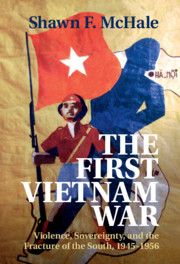Book contents
- The First Vietnam War
- The First Vietnam War
- Copyright page
- Contents
- Figures
- Tables
- Acknowledgments
- Abbreviations
- Introduction: Sovereignty, Violence, and Institutional Collapse at the Edge of France’s Empire
- Part I Fracture, 1945–1947
- Part II Disassemblage/Reassemblage, 1947–1953
- 5 Empire, Racial Survival, and Race Hatred
- 6 Contesting State and Sovereignty
- 7 Forced Migrations and Suffering
- 8 French Pacification Meets the Vietnamese Resistance
- 9 Alternative Trajectories: Seeing like Parastates, Militias, and Strongmen
- Part III Endgame, 1953–1956
- Bibliography
- Index
8 - French Pacification Meets the Vietnamese Resistance
from Part II - Disassemblage/Reassemblage, 1947–1953
Published online by Cambridge University Press: 17 August 2021
- The First Vietnam War
- The First Vietnam War
- Copyright page
- Contents
- Figures
- Tables
- Acknowledgments
- Abbreviations
- Introduction: Sovereignty, Violence, and Institutional Collapse at the Edge of France’s Empire
- Part I Fracture, 1945–1947
- Part II Disassemblage/Reassemblage, 1947–1953
- 5 Empire, Racial Survival, and Race Hatred
- 6 Contesting State and Sovereignty
- 7 Forced Migrations and Suffering
- 8 French Pacification Meets the Vietnamese Resistance
- 9 Alternative Trajectories: Seeing like Parastates, Militias, and Strongmen
- Part III Endgame, 1953–1956
- Bibliography
- Index
Summary
It is common to argue that the communist-led Democratic Republic of Vietnam, following the theory of "people's war," defeated the French in the First Indochina War. This argument is correct everywhere except for southern Vietnam. France's slow and systematic implementation of what it called "pacification," in concert with allied self-defense and paramilitary forces, slowly brought increasing parts of the Mekong Delta under the control of France and its allies. In reaction, The Resistance pursued a four-prong strategy: 1) they strengthened the communist core of the Resistance by recruiting cadres, purging "unreliable" non-communists, and working to capture control of the Resistance at all levels; 2) they reached out to potential allies like the Khmer, Chinese, Buddhists, and Catholics; 3) they practiced outreach towards rivals and enemies through proselytization (Địch vận); 4) they strengthened Resistance ability to engage in a sophisticated repertoire of violence ranging from intimidation to conventional warfare. Despite this sound strategy, the Resistance precipitously shifted to conventional warfare. The French-led forces took advantage of this costly mistake. France's commission of war crimes in keeping food from the population, its access to increased American funding after 1949, and contingent factors also contributed to Resistance failure.
Keywords
- Type
- Chapter
- Information
- The First Vietnam WarViolence, Sovereignty, and the Fracture of the South, 1945–1956, pp. 195 - 234Publisher: Cambridge University PressPrint publication year: 2021



